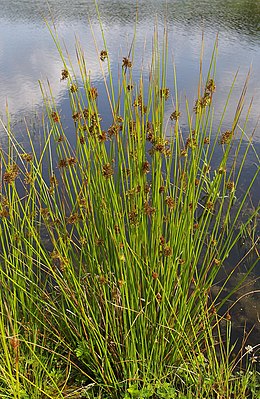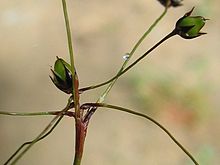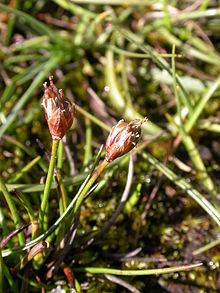Rushes
| Rushes | ||||||||||||
|---|---|---|---|---|---|---|---|---|---|---|---|---|

Flutter rush ( Juncus effusus ) |
||||||||||||
| Systematics | ||||||||||||
|
||||||||||||
| Scientific name | ||||||||||||
| Juncaceae | ||||||||||||
| Yuss. |
The plant family of the rush family (in Germany and partly in Switzerland and Liechtenstein common name) or cornice (common name in Austria) (Juncaceae) belongs to the order of the sweet grass (Poales). Most of the over 400 species belong to the two globally widespread ( cosmopolitan ) genera of the rushes or cornices ( Juncus ) and the grove ( Luzula ).
description

Vegetative characteristics
Deciduous, but also many wintergreen species are represented among the rush plants. Predominantly it is perennial herbaceous plants , few species are annuals . The genera of the family are very different in appearance. Their vegetative reproduction takes place in the majority via runners (rhizomes). Few species are clumpy . The species of the genus Distichia form compact pads.
The leaves are mostly basal and almost always three-lined, rarely two-lined (genus Distichia ). While the rushes have mostly round, often rigidly upright, stem-like and bare leaves in cross-section, the grove rushes usually have grass-like and often hairy leaf blades. The leaf blades are glabrous in most species (e.g. Juncus ), round or flattened round in cross-section. The stem-like leaves can be compactly filled with a white pith and divided into layers by transverse pith layers. The base of the shoot is often covered by leaf sheaths without spade. These are open at the rushes and often heard at the top in the transition to the Spreite. The leaf sheaths of the grove, however, are always closed. The leaf blades are flat, grass-like or at most runny. They are hairy at least in the area of the vaginal opening.
Generative characteristics
The flowers of the rush family are in most cases hermaphroditic. The inflorescence of the rush family is a modified form of the panicle , namely a spirre . The marginal or lower flowers have the longest stalk, while the central or upper ones are more compressed. This creates an almost funnel-shaped structure. Several flowers can also be grouped in a cluster.
The basic structure of the small flowers is similar to those of the lily family (Liliaceae). The flower organs - six bloom cladding ( tepals ), six stamens (stamen) and three carpels (carpels) - are formed regularly and most complete. The bloom cladding sheets (perianth) are converted to husk-like scales. They are colored green to brown, purple or black, sometimes also transparent. The number of stamens is rarely reduced to three. The pollen grains are always aggregated in packets of four. The ovaries are always superordinate and end in three relatively long, papillary, often twisted scar branches .

The fruit type of the rush family is the three- to multi-seeded capsule fruit . In the rushes this is multi-seeded and divided into three parts by internal ribs (placentas). The capsules of the grove are single-compartment and have three seeds inside each at the base. While long white appendages ( elaiosomes ) are present at the end of the seeds of the grove , in the rushes there are only exceptionally membranous appendages .
ecology
The pollination occurs predominantly by the wind ( anemophily ) or insects ( Entomogamie ). In a few species, self-pollination is possible ( autogamy ).
The seeds are spread by the wind ( anemochory ), through the adherence of the fruits in the plumage or in the fur of animals ( epichory ). The spread of ants ( myrmecochory ) is predominant in the grove. The fatty appendages of the seeds serve as food for the ants. The seeds are carried into the ant burrows and transported to other places.
Locations
While the species of the genus Juncus predominantly colonize moist to wet locations such as moors , swamps , waterfronts or wet meadows , the species of the genus Luzula prefer drier soils and shady locations such as forests and bushes. The latter are often associated with ant-rich biotopes .
Systematics and distribution
The Juncaceae family was established by Antoine Laurent de Jussieu .
The rush plants of the genera Juncus and Luzula are distributed worldwide in the temperate and arctic regions of both hemispheres . In the tropics , their occurrence is limited to the higher elevations of the mountains. The other genera occur exclusively in South America, Marsippospermum and Rostkovia also in New Zealand .
The Juncaceae family contains about seven genera with about 430 species.
- Distichia Nees & Meyen : The three species thrive in South America from Colombia to northern Argentina and Chile.
- Rushes ( Juncus L. , including Oreojuncus Záv.Drábk. & Kirschner ): There are around 300 species. The genus is cosmopolitan.
- Grove rims ( Luzula DC. ): There are about 122 species. The genus is cosmopolitan.
- Marsippospermum Desv. : The fouror sospecies occur in southernmost South America, the Falkland Islands and New Zealand.
-
Patosia Buchenau : There is only one type:
- Patosia clandestina (Phil.) Buchenau : It occurs in Bolivia, Chile and Argentina .
- Oxychloe Philippi : The five species thrive in Bolivia, Peru, Argentina, and northern Chile.
- Rostkovia Desv. : The two species occur in Ecuador, New Zealand and from southernmost South America to the sub-Antarctic islands.
photos
Chamois bulrush inflorescence ( Juncus jacquinii )
Field grove ( Luzula campestris )
Snow ledges ( Luzula nivea )
Marsippospermum gracile , illustration
Patosia clandestina in Chile
swell
Family descriptions :
- The Juncaceae family on the AP website. (Section systematics)
- The Juncaceae family at DELTA by L. Watson and MJDallwitz. (Section description)
- Ralph E. Brooks, Steven E. Clemants: Juncaceae. - Same text online as the printed work , In: Flora of North America Editorial Committee (Ed.): Flora of North America North of Mexico. Volume 22: Magnoliophyta: Alismatidae, Arecidae, Commelinidae (in part), and Zingiberidae , Oxford University Press, New York and Oxford, 2000, ISBN 0-19-513729-9 . (Section description)
- Guofang Wu, Steven E. Clemants: Juncaceae. , P. 44 - online with the same text as the printed work , In: Wu Zheng-yi, Peter H. Raven (Ed.): Flora of China. Volume 24: Flagellariaceae through Marantaceae , Science Press and Missouri Botanical Garden Press, Beijing and St. Louis 2000, ISBN 0-915279-83-5 . (Section description)
- Family description in the Flora of New Zealand . (English)
Individual evidence
- ^ Manfred A. Fischer, Karl Oswald, Wolfgang Adler: Excursion flora for Austria, Liechtenstein and South Tyrol . 3rd, improved edition. State of Upper Austria, Biology Center of the Upper Austrian State Museums, Linz 2008, ISBN 978-3-85474-187-9 . , Pp. 1091, 1102
- ^ Michael G. Simpson: Plant Systematics. Second Ecdition . 2nd Edition. Academic Press, Berlington / San Diego / Oxford 2010, ISBN 978-0-12-374380-0 , pp. 740 .
- ↑ The family at the AP website .
- ↑ a b c d e f g h i Rafaël Govaerts (ed.): Juncaceae. In: World Checklist of Selected Plant Families (WCSP) - The Board of Trustees of the Royal Botanic Gardens, Kew . Retrieved August 17, 2018.






